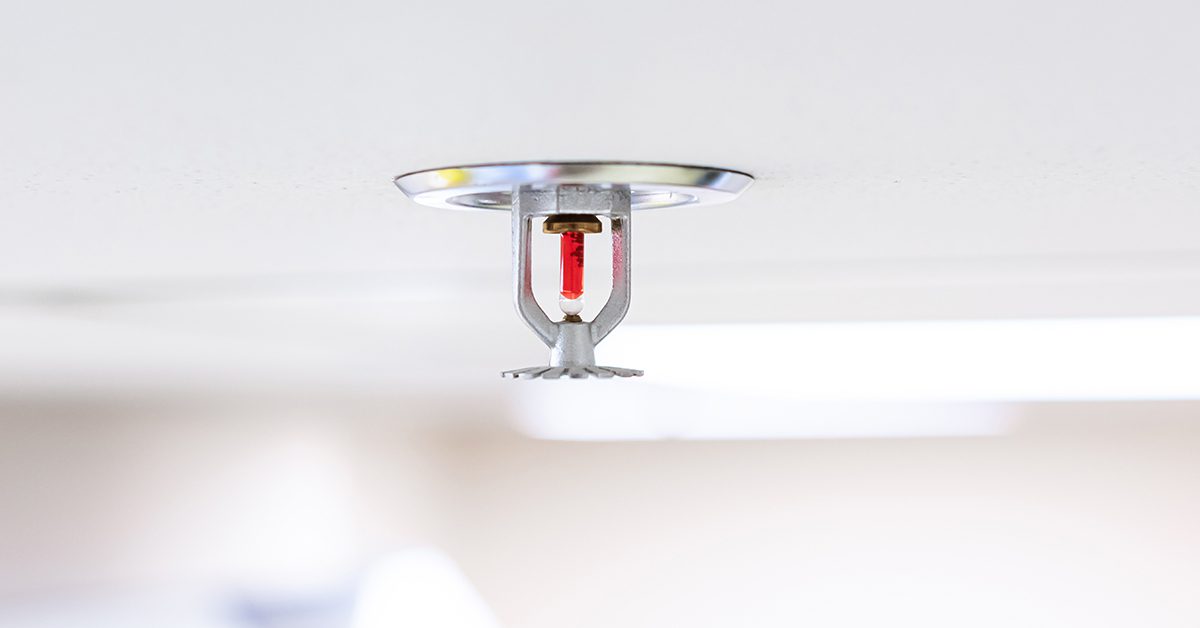Fire sprinklers are vital to your home or office building’s safety infrastructure. These systems often act as the first line of defense when a fire ignites. Sprinklers have a success rate of controlling 96 percent of the fires in which they’re activated, resulting in 89 percent fewer civilian fatalities, 27 percent fewer civilian injuries, and 60 percent fewer firefighter injuries. However, as with any mechanical system, sprinklers need regular maintenance—so here’s how to maintain optimal functionality.
Fire Sprinkler Inspections: Monitor Your System’s Working Order
Routine inspections will reveal the condition of your fire sprinklers and catch early signs of a potential cause for malfunction, such as leakage, fluid loss, physical damage, corrosion, and electrical short-circuiting. The frequency of inspections might vary based on certain factors like building codes, local ordinances, or the type of fire sprinkler system installed (e.g., wet, dry, or deluge). However, the National Fire Protection Association (NFPA) has established some baseline parameters to follow for maximum efficacy:
Weekly Inspections
Perform a basic visual check of the system at least once a week. Pay attention to visible signs of obstruction, tampering, or external damage on the sprinkler heads. Then, the pipes are located and checked for issues similar to those mechanisms.
Monthly Inspections
Conduct a more thorough inspection about once a month. Monitor the control and pressure valves, alarm systems, electrical circuits, and other system components to ensure each part works. This will indicate whether repairs might be necessary.
Quarterly Inspections
Schedule a comprehensive system check with a qualified technician every three months. This professional will test the water flow, examine all components for corrosion or other internal damage, and ensure the system complies with relevant codes.
Annual Inspections
Hire a licensed professional to conduct a full outer and inner inspection once a year. This means testing all alarm systems, control and pressure valves, and flow switches. It should also include performing a hydraulic calculation to ensure the system can deliver the right amount of water to each fire sprinkler head in an emergency.
Fire Sprinkler Maintenance: Extend the Longevity of Your System
It’s a common misconception that fire sprinkler systems can cause interior flooding, but while this isn’t a concern, other potential issues can obstruct your sprinklers’ function. Fortunately, with routine maintenance, those glitches are preventable. The following measures can help extend the whole system’s lifespan for as long as possible while alerting you to areas of malfunction that need to be repaired or replaced. These simple but crucial maintenance tasks could ultimately save a life:
Clear the Area Around Each Sprinkler Head
Ensure no physical obstructions are near the sprinkler heads, which could block the water spray during an actual fire. Do not hang any objects within several feet of all ceiling sprinkler heads. If you have sidewall sprinklers, do not mount any decorative or storage features on the wall beside them. Sprinkler heads require a barrier-free zone to operate.
Check Control and Pressure Valve Function
Monitor the control and pressure valves to confirm they’re in the correct position with no leakage. All valves should be open so that water can flow through the system and out of the sprinkler heads if a fire occurs. The system also needs to maintain a consistent, adequate level of water pressure at all times, so look for any signs of pressure fluctuation.
Test the Alarm Systems regularly
Ensure all alarms connected to the fire sprinkler system are functioning correctly. Run tests to see if the alarm sensors will audibly react to smoke or flames, then check whether the automatic monitoring system is wired to notify local first response agencies of a fire incident. This will reveal any electrical problems that require professional assistance.
Monitor Pipes for Corrosion or Other Issues
Check all pipes associated with the fire sprinkler system for corrosion, leaks, or other structural damage. These issues can prevent water from reaching the sprinkler heads and deteriorate the system. If you notice plumbing hazards, call a repair technician immediately before the damage worsens and necessitates a total system replacement.
Keep Records of All Maintenance Activities
Record any maintenance tasks you perform on the fire sprinkler system, including tests, repairs, visual checks, and thorough inspections. These records can be invaluable when you need to file an insurance claim, demonstrate regulatory compliance, schedule a professional maintenance service, and track recurring issues that need more careful attention.
Caring for Your Sprinkler System Is an Investment in Your Safety
Consistent fire sprinkler maintenance will ensure reliable operation and maximum safety for all building occupants. When you prioritize routine system inspections and stay on top of regular maintenance tasks, you’ll avoid severe malfunctions so the sprinklers can respond effectively if a fire ignites. The NFPA estimates that a single-family home will incur just a 3 percent loss in a fire when sprinklers activate, and a business will only suffer a 1.3 percent loss. In other words, sprinkler maintenance is an investment in your peace of mind.





Be First to Comment